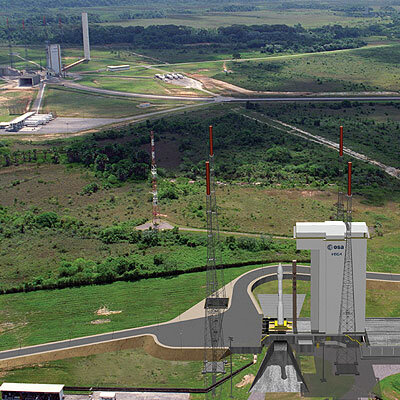The first stone for Vega at Europe's Spaceport
The construction site for the ground segment of Vega, the small European launcher, was opened at Europe's Spaceport in Kourou, French Guiana last month. Vega is due to be launched at the end 2007 and will complement the European mid-class Soyuz and heavy-class Ariane 5 launchers.
The site was formally inaugurated on 20 October by ESA together with CNES and Italian company Vitrociset, prime contractor for the ground segment. This is the start of a new life for ELA1, the launch pad originally used for the Ariane 1 European launcher, 15 years after its deactivation. The new launch pad (ZLV - Zone de Lancement Vega) is being built on the ELA1 foundations.
The choice of the Kourou Spaceport to build the new Vega ground segment infrastructure meets one of the main requirements of the Vega programme; namely to provide a high-quality launch service whilst limiting the cost by re-use of existing facilities and expertise.

Activities will start with the fencing of the area, the partial renovation of the bunker and waterproofing, metallic fixture installation, removal of the old ELA1 launch table, the installation of the 'evacuation chamber', set up of telecommunications network, as well as the refurbishment of the building that will be used for temporary lodging of personnel.
Prime contractor Vitrociset and its subcontractors will work with the support of local contractors, guaranteeing additional work for Europe's Spaceport and the companies involved. The site is due for completion in April 2007, in time for Vega's qualification flight at the end of 2007. During the exploitation phase, from 2008, the Vega Launch Service will be then operated by Arianespace.
More about Vega's ground segment infrastructure

The Vega launch zone (ZLV), located on the old ELA1 site, comprises a permanent infrastructure (the bunker) and a mobile building (the gantry).
The bunker includes:
- the launch table that ensures the launcher keeps its vertical position and that provides the interface with the exhaust duct
- the umbilical mast that ensures the launcher and payload's conditioning and power supply until the very last moment before lift-off. It has to secure the correct disconnection of those systems from the launcher during lift-off.
- the exhaust ducts through which the burning gases are expelled at ignition
- four anti-lightning masts
- various premises such as safety room, fluid room and gantry connection room
The gantry, which is rolled back before the final countdown, provides the infrastructure necessary for the launcher integration, and is composed mainly of:
- hoisting devices for the erection of the stages
- platforms to access to the different levels of the launcher
- connection and supply facilities
- propellant fuelling installations for the fourth stage, known as the Altitude and Vernier Upper Module (AVUM) or liquid propellant stage
- safety systems

The Launch Control Centre for Vega will be located in CDL3 (the control centre built for Ariane 5) which allows independent operational and monitoring systems dedicated to Vega, as shared components with Ariane.
Vega will also benefit from shared use of the general facilities of the European Spaceport such as the satellite preparation area, Jupiter control centre for coordinating launch operations and facilities, storage sites, technical support services (transport, flight phase tracking, flight data processing for post-flight analysis, and meteorological data).
Evolution of the launch pad
Almost thirty years have passed since the initial launch pad built in the late 60s for the Europa 2 launcher was modified into ELA1 to meet the requirements of the first Arianes. Since then, two other ESA-funded launch pads, ELA2 and ELA3, have been built to support the later Ariane launchers. launchers. Today, only ELA3 - dedicated to Ariane 5 - remains in use.






